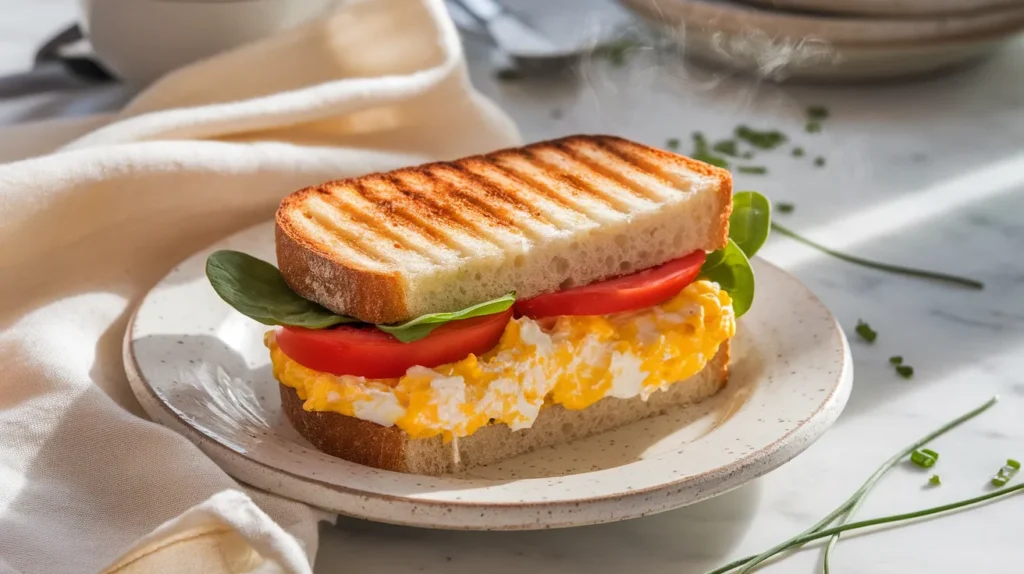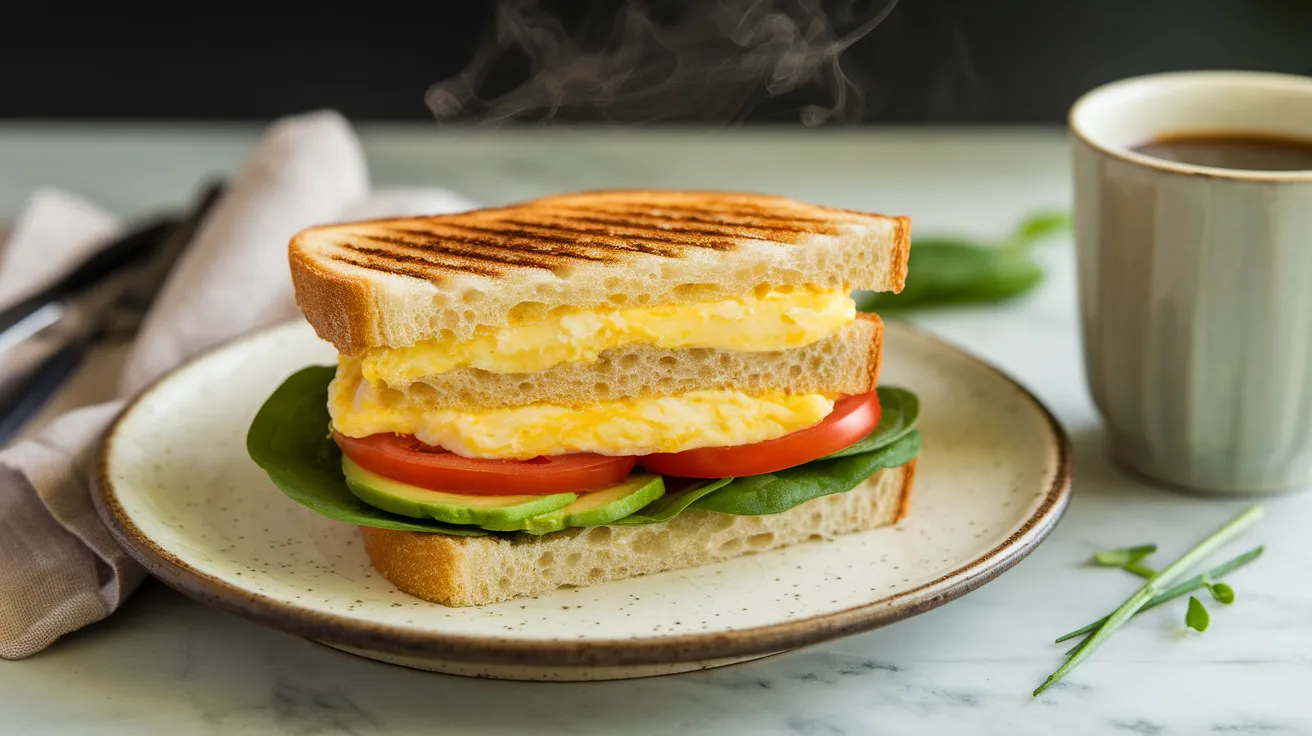Imagine biting into a perfectly toasted sandwich where creamy ricotta cheese meets fluffy scrambled eggs, creating the dreamiest breakfast comfort food you’ve ever tasted. This ricotta egg sandwich combines rich, cloud-like eggs with smooth ricotta for a protein-packed morning meal that tastes like brunch at your favorite café but comes together in just 15 minutes on your busiest weekday.
SERVES: 4 | PREP: 10 MIN | COOK: 5 MIN | TOTAL: 15 MIN
Ingredients You’ll Need
For the Egg Mixture:
| Ingredient | Amount |
|---|---|
| Large eggs | 8 eggs |
| Whole milk ricotta cheese | 1 cup |
| Salt | 1 teaspoon |
| Black pepper | ½ teaspoon |
| Butter | 2 tablespoons |
| Fresh chives, chopped | 2 tablespoons |
For Assembly:
| Ingredient | Amount |
|---|---|
| Sourdough bread slices | 8 slices |
| Baby spinach leaves | 2 cups |
| Tomato, sliced thin | 1 large |
| Avocado, sliced | 1 large |
| Olive oil | 2 tablespoons |
Step-by-Step Instructions
Phase 1: Prep Your Ingredients (5 minutes)
Step 1: Take your eggs and ricotta cheese out of the refrigerator 10 minutes before cooking. Room temperature ingredients blend together more smoothly and create fluffier eggs because cold ingredients can shock the eggs during cooking and make them tough.
Step 2: Crack all 8 eggs into a large mixing bowl, being careful to check each egg for shell fragments. Fish out any pieces with a spoon – they’re easier to catch now than after cooking.
Step 3: Add the ricotta cheese directly to the eggs. The ricotta will create pockets of creamy texture throughout your scrambled eggs instead of mixing in completely.
Step 4: Whisk the egg mixture for exactly 30 seconds – just until you see streaks of yellow and white combining. Over-whisking incorporates too much air and makes the eggs rubbery when cooked.
Step 5: Season with salt and black pepper now rather than after cooking. This allows the seasoning to distribute evenly throughout the eggs.
Phase 2: Toast Your Bread (3 minutes)
Step 6: Heat a large skillet over medium heat and brush each sourdough slice lightly with olive oil on both sides. The oil helps create a golden, crispy exterior while keeping the inside soft.
Step 7: Toast the bread in batches for 2 minutes per side until you see golden-brown color and hear a light crunch when you tap it with your spatula. Don’t walk away – bread goes from perfect to burnt in seconds!
Step 8: Remove toasted bread to a plate and cover with a clean kitchen towel. This keeps the bread warm and prevents it from getting soggy while you cook the eggs.
Phase 3: Create Perfect Ricotta Scrambled Eggs (5 minutes)
Step 9: Melt butter in the same skillet over medium-low heat. When the butter foams and you can smell that nutty aroma, it’s ready. Lower heat is crucial for creamy eggs – high heat makes them dry and rubbery.
Step 10: Pour your egg and ricotta mixture into the skillet. Wait 20 seconds without touching it. You’ll see the edges just starting to set – this creates the foundation for creamy curds.
Step 11: Using a silicone spatula, gently push the eggs from the outer edge toward the center in slow, sweeping motions. Tilt the pan so uncooked egg flows into the empty spaces.
Step 12: Continue this gentle pushing and tilting for 3-4 minutes. The eggs should look glossy and slightly wet when they’re done – they’ll continue cooking from residual heat after you remove them from the pan.
Step 13: When eggs are 80% cooked (still slightly runny on top), remove from heat immediately. Stir in fresh chives while the eggs finish cooking off the heat.
Phase 4: Assemble Your Sandwiches (2 minutes)
Step 14: Place 4 toasted bread slices on a clean cutting board. Layer spinach leaves on each slice first – the warmth of the bread will slightly wilt them.
Step 15: Divide the ricotta scrambled eggs evenly among the 4 sandwiches, mounding them generously in the center. Each sandwich should have about ½ cup of the egg mixture.
Step 16: Add 2-3 thin tomato slices on top of the eggs. Pat tomatoes dry with a paper towel first to prevent soggy bread.
Step 17: Fan 3-4 avocado slices over the tomatoes. The creamy avocado complements the ricotta beautifully and adds healthy fats.
Step 18: Top each sandwich with the remaining toasted bread slices. Press down gently to help everything stick together.
Step 19: Using a sharp serrated knife, cut each ricotta egg sandwich diagonally. This creates the classic sandwich presentation and makes them easier to eat.
Step 20: Serve immediately while the eggs are still warm and creamy. These ricotta egg sandwiches taste best fresh and don’t hold well if assembled in advance.
Chef’s Notes
Temperature Control is Everything: The secret to restaurant-quality ricotta egg sandwiches lies in cooking your eggs low and slow. Medium-low heat prevents the proteins from tightening up too quickly, keeping your eggs impossibly creamy.
Ricotta Quality Matters: Use whole milk ricotta rather than part-skim for the richest, creamiest texture. The extra fat content creates those luxurious pockets of cheese throughout the eggs that make this ricotta egg sandwich special.
Timing Your Toast: Start toasting your bread before you cook the eggs. This ensures everything comes together hot and fresh. Cold toast makes for a disappointing sandwich.
The Barely-Cooked Secret: Remove eggs from heat when they still look slightly underdone. They’ll finish cooking from their own heat while you assemble, resulting in perfectly creamy eggs instead of dry, overcooked ones.
Nutrition Information (Per Sandwich)
Calories: 485 | Protein: 24g | Carbohydrates: 38g | Fat: 26g | Fiber: 5g | Sodium: 680mg
Creative Variations
Mediterranean Ricotta Egg Sandwich: Swap regular tomatoes for sun-dried tomatoes and add crumbled feta cheese. Spread pesto on your toasted bread and include fresh basil leaves. This variation adds a tangy, herbaceous twist.
Spicy Southwest Style: Mix in diced jalapeños with the eggs and top with pepper jack cheese instead of plain ricotta. Add sliced avocado and a drizzle of hot sauce for breakfast with a kick.
Italian-Inspired Version: Layer prosciutto or crispy pancetta into your sandwich and use fresh mozzarella alongside the ricotta. If you love unique ricotta combinations, try our ricotta egg salad for another Italian-inspired breakfast option.
Sweet and Savory: For a unique twist, add a thin layer of fig jam to your toasted bread before adding the ricotta eggs. The sweetness pairs surprisingly well with the creamy eggs, similar to how we combine flavors in our ricotta flourless pancakes.
Storage & Reheating Guide
Storing Components Separately: Cook extra ricotta scrambled eggs and store them in an airtight container in the refrigerator for up to 2 days. Keep the bread and toppings separate to prevent sogginess.
Freezing Option: While assembled sandwiches don’t freeze well, you can freeze the cooked eggs for up to 1 month. Thaw in the refrigerator overnight before reheating.
Reheating Ricotta Eggs: Warm eggs in a skillet over low heat with a splash of milk, stirring gently. Microwave reheating works in 30-second intervals, but stovetop gives better texture.
Make-Ahead Strategy: Prep all ingredients the night before – whisk eggs with ricotta, slice vegetables, and store in separate containers. In the morning, you’ll have this ricotta egg sandwich on the table in 10 minutes.
Meal Prep Warning: Don’t assemble these sandwiches more than 5 minutes before eating. The moisture from the eggs will make the bread soggy quickly.

Troubleshooting Common Problems
Problem 1: Rubbery, Tough Eggs Your heat was too high or you overcooked the eggs. Ricotta scrambled eggs need gentle heat and should be removed from the pan while still slightly wet. They continue cooking from residual heat.
Problem 2: Watery Eggs This happens when ricotta releases too much moisture. Make sure you’re using full-fat ricotta and don’t whisk the egg mixture too vigorously. Some ricotta brands are wetter than others – strain very wet ricotta through cheesecloth for 10 minutes before using.
Problem 3: Soggy Bread Your bread wasn’t toasted enough or you assembled the sandwich too far in advance. Toast should be crispy enough to hold up to the moisture from eggs and vegetables. Always pat tomatoes dry with paper towels.
Problem 4: Bland Flavor Season generously! Eggs need more salt than you think. Add salt to the raw egg mixture and taste a tiny cooked bit to adjust. Fresh black pepper and herbs make a huge difference.
Problem 5: Dry, Crumbly Texture You cooked the eggs too long or at too high heat. The ricotta should create creamy pockets, but overcooking causes the moisture to evaporate. Always use low heat and remove from stove when eggs still look wet.
Equipment Essentials
- Large non-stick skillet (10-12 inches) – Essential for even cooking
- Silicone spatula – Prevents scratching and gets into pan corners
- Sharp serrated knife – Cuts cleanly through sandwich without squishing
- Mixing bowl (medium size) – For whisking eggs
- Wire whisk – Blends ricotta into eggs smoothly
- Cutting board – For assembling sandwiches
- Kitchen towels – Keeps toast warm
- Measuring cups and spoons – For accurate proportions
Shopping List by Store Section
Dairy Case:
- 1 dozen large eggs
- 1 container (15 oz) whole milk ricotta cheese
- 1 stick butter
Produce Section:
- 1 bunch fresh chives
- 1 container baby spinach
- 1 large tomato
- 1 ripe avocado
Bakery:
- 1 loaf sourdough bread (need 8 slices)
Pantry/Staples:
- Salt
- Black pepper
- Olive oil
Success Secrets from the Test Kitchen
1. The Golden Ratio: Use exactly 2 tablespoons of ricotta per egg. This creates the perfect balance where you taste both the eggs and the creamy cheese without one overpowering the other.
2. Temperature Test: Your skillet is ready when a drop of water sizzles and evaporates in 2-3 seconds. Too hot and water bounces around frantically; too cool and it just sits there.
3. The Spatula Technique: Push eggs slowly from edge to center using the flat side of your spatula, not the edge. This creates large, soft curds instead of small, dry pieces.
4. Bread Selection Matters: Choose bread with a tight crumb (small holes). Large, airy ciabatta holes let eggs seep through and create a mess. Sourdough, brioche, or challah work perfectly.
5. The 30-Second Rule: After plating, wait exactly 30 seconds before cutting your ricotta egg sandwich. This lets the eggs set slightly so they don’t ooze out when you slice through.
Pro Tip: Make a double batch of the ricotta scrambled eggs and save half for tomorrow’s breakfast. They reheat beautifully and taste even better the next day when the flavors have melded together overnight!




